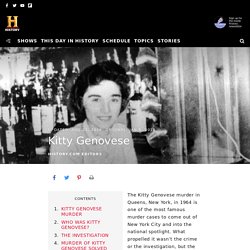

What Is the Bystander Effect? If you witnessed an emergency happening right before your eyes, you would certainly take some sort of action to help the person in trouble, right?

While we might all like to believe that this is true, psychologists suggest that whether or not you intervene might depend upon the number of other witnesses present. What Is the Bystander Effect? The term bystander effect refers to the phenomenon in which the greater the number of people present, the less likely people are to help a person in distress. When an emergency situation occurs, observers are more likely to take action if there are few or no other witnesses. Being part of a large crowd makes it so no single person has to take responsibility for an action (or inaction). Factors Causing The Bystander Effect. Journal Article #1: The Bystander-Effect: A Meta-Analytic Review on Bystander Intervention in Dangerous and Non-Dangerous Emergencies. Journal Article #1: The Bystander-Effect: A Meta-Analytic Review on Bystander Intervention in Dangerous and Non-Dangerous Emergencies.
Journal Article #2: A Student in Distress: Moral Frames and Bystander Behaviour in School. Journal Article #2: A Student in Distress: Moral Frames and Bystander Behaviour in School. Journal Article 2: A Student in Distress: Moral Frames and Bystander Behaviour in School. THE BYSTANDER EFFECT. An experimental video on Bystander Effect. The Science of Empathy. (127) The Bystander Effect: Why Some People Act and Others Don't. Toddler incident in China shows 'volunteer's dilemma'. A security camera video of a toddler being run over twice on a street in China has swept across the Web in recent days and has drawn a chorus of horrified denunciations.

How, we wonder, could so many passers-by have so callously ignored the girl's plight? As humans, we are horrified when we learn that a person in distress is not helped, even when, as in this case, many potential helpers are present. Our horror increases if the person is victimized in a particularly vicious or careless way by fellow human beings. Our horror is further heightened when we learn that the victim is helpless and the kind of person who normally stimulates our instinct to aid and protect. YouTube - Broadcast Yourself. Kitty Genovese.
The Kitty Genovese murder in Queens, New York, in 1964 is one of the most famous murder cases to come out of New York City and into the national spotlight.

What propelled it wasn’t the crime or the investigation, but the press coverage that alleged the murder had many witnesses who refused to come to the Kitty Genovese’s defense. This has been disproved over time, but not before it became part of the accepted lore of the crime. Kitty Genovese was returning from work home at around 2:30 a.m. on March 13, 1964, when she was approached by a man with a knife. Genovese ran toward her apartment building front door, and the man grabbed her and stabbed her while she screamed. A neighbor, Robert Mozer, yelled out his window, “Let that girl alone!” The Bystander Effect:The Death of Kitty Genovese. Decision Model of Helping - IResearchNet. Decision Model of Helping Definition The decision model of helping, introduced in The Unresponsive Bystander by Bibb Latane and John Darley, outlines a process of five steps that will determine whether a bystander will act or not in a helping situation.

This model is also intended to offer a counterargument to the proposition that people do not help in emergencies simply because they become apathetic. As Latane and Darley suggest, an individual’s interpretation of the emergency may be more influential than the individual’s general motivation when it comes to his or her actions in an emergency. The decision model of helping outlines the five steps to helping behavior. The Decision Model by Bibb Latane and John Darley. Poster. Textbook: Pearson (11.1 "How is our behaviour affected by the social situation?")